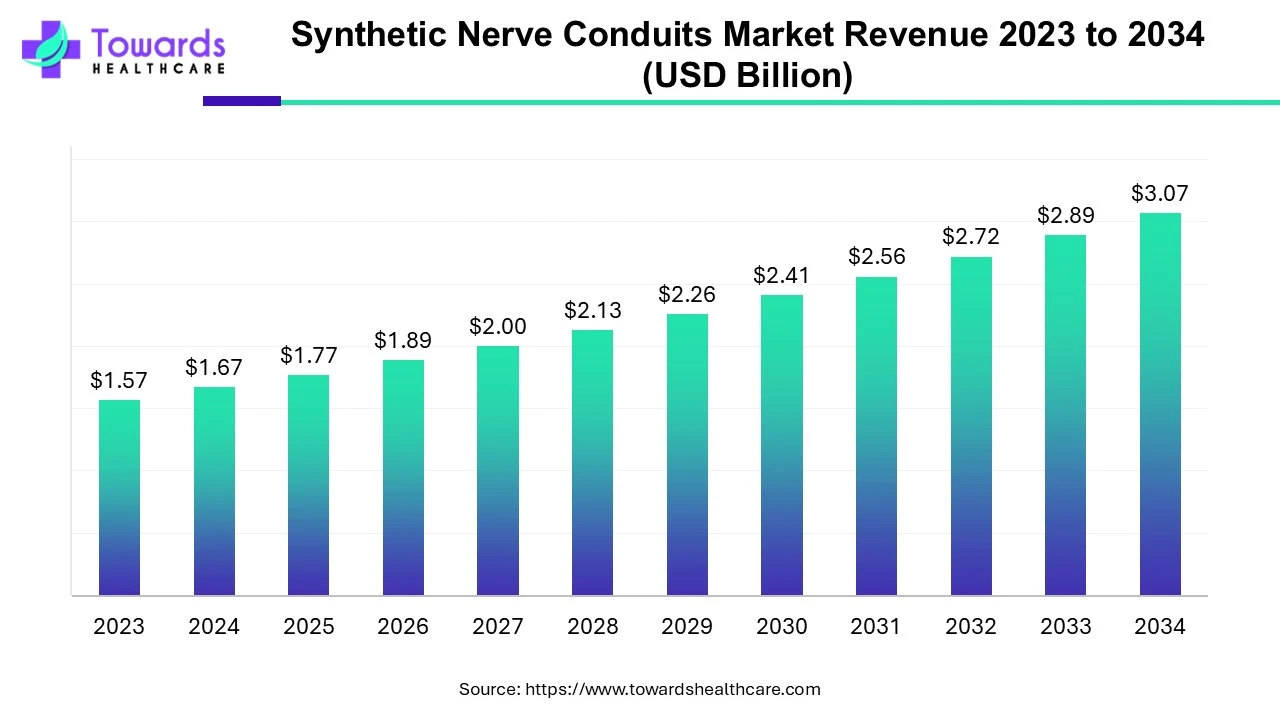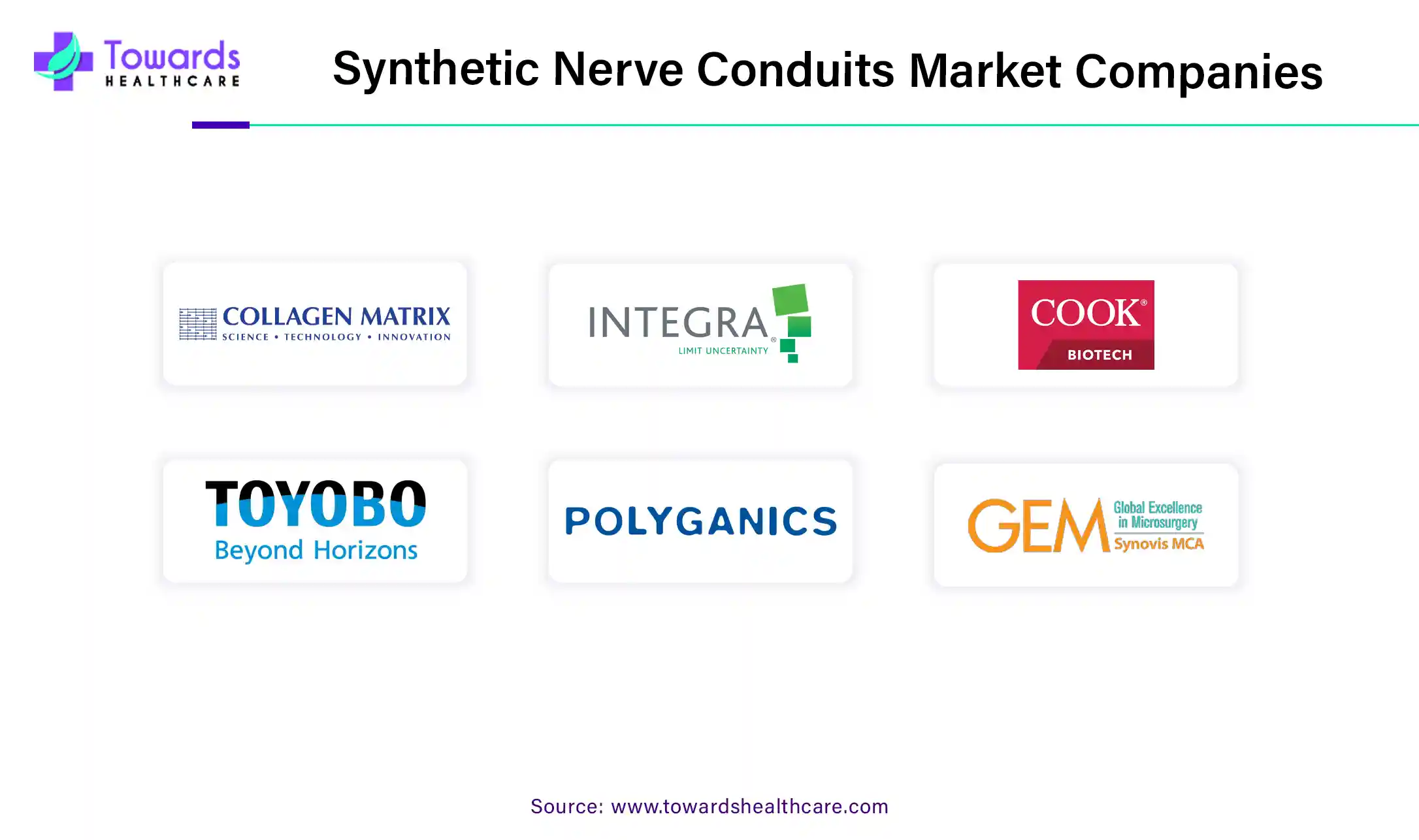November 2024


Principal Consultant

Reviewed By
The global synthetic nerve conduits market was estimated at US$ 1.57 billion in 2023 and is projected to grow to US$ 3.07 billion by 2034, rising at a compound annual growth rate (CAGR) of 6.29% from 2024 to 2034. The rising demand for nerve regeneration using a biodegradable material which is attributed to restoring nerve functions after a severe nervous system injury that interrupts motor and sensory functions leads to increasing the adoption of synthetic nerve conduits market.

Synthetic nerve conduits play a crucial role in nerve tissue engineering. This encompasses nerve autograft as the standard treatment for bridging gaps (>30mm) between the proximal and the distal nerve stumps, promoting nerve regeneration. The synthetic nerve conduit market is growing as synthetic polymers are better simulants for the physical and chemical properties of nerve tissue.
Therefore, this technology has made a significant impact in the field of biological regeneration. This procedure is conducted using degradable or non-degradable material. The biodegradable material has the property to degrade and disappear during cell growth without harming the host body.
Artificial intelligence (AI) and other advanced technologies can help to detect peripheral nerve injury and suggest appropriate treatment regimens. Artificial neural networks (ANN) can be used to test connections and communications between neurons. AI can also be used to identify and quantitatively assess the morphology and structure of neurons via imaging techniques. AI can also be used to enhance the understanding of neural regeneration. It can suggest various materials or polymers for preparing synthetic nerve conduits. Integrating AI in the 3D bioprinting technique leads to the preparation of customized nerve conduits based on the patient’s condition and requirements. Additionally, it can aid in computational scaffold design.
The rising incidences of peripheral nervous system disorders and the increasing demand for effective treatment result in growing research and development activities. Nerve conduits should be biodegradable, soft, and pliable. Numerous synthetic polymers are readily available for the preparation of synthetic nerve conduits. However, several researchers are investigating and synthesizing novel materials or polymers for nerve conduits to improve their treatment outcomes and enhance their efficiency. The combination of various synthetic, biodegradable polymers requires R&D. The growing R&D activities are further driven by increasing investments and public-private collaborations. Several government and private organizations provide funding for synthetic nerve conduit research.
3D bioprinting technology is used to create scaffold structures with the help of biological ink. The development of the bioprinting strategy promoted advancement in neural tissue regeneration and personalized treatment. Presently, the popular 3D bioprinting techniques for neural tissue engineering are the inkjet 3D bioprinting technique, laser-assisted printing, and extrusion-based method. To conclude, although 3D printing is a rapidly developing technology, still there is a lot to explore in this field to enhance its potential mechanism in nerve regeneration and transform clinical applications.
For instance,
Under synthetic nerve conduit, autologous nerve grafting is restricted by the availability of expandable donor nerves and donor site morbidity. Nerve conduit is known as the alternative to autologous grafts, but the use of large-diameter nerve deficits for nerves such as the median, radial, and ulnar nerves is still untested both experimentally and clinically. Currently, conduits are performed on nerves with less than 3 cm of small diameter, such as the radial and sensory nerves. This restraint of development leads to slowing down the synthetic nerve conduit market.
North America dominated the synthetic nerve conduits market in 2023. The region is experiencing dominance due to the increasing prevalence of peripheral nerve damage. According to Oregon Health & Science University (OSHU), it is estimated that peripheral neuropathy ranges from at least 20 million to 30 million people in the United States. Another factor that contributes to the superiority of the synthetic nerve conduit market in North America is advanced healthcare facilities. Mayo Clinic in Rochester, Minnesota is ranked among the best hospitals for neurology and neurosurgery, the experts at Mayo Clinic have treated more than 20,000 people with peripheral nerve injuries.
Europe is observed to grow at a notable rate in the synthetic nerve conduits market in predicted timeframe. The growth in this region is linked with expanding research institutes and universities which as equipped with state-of-the-art facilities and cutting-edge research and regenerative medicine.
The leading country in the European region is Germany, which has significantly risen in the field of tissue engineering. Along with this, a collaborative research environment is observed in Germany with other scientists, clinicians and industrial experts which leads to rapid development and implementation in regenerative therapies, contributing to the growth of the synthetic nerve conduits market.
By nerve, the peripheral nerve segment dominated the synthetic nerve conduits market in 2023. The dominance is due to the increasing incidence rate of peripheral nerve injury. Globally, 1 million PNI (peripheral nerve injury) and about half a million people in the United States undergo surgical procedures costing up to $1.5 billion each. A synthetic polymer tubular structure is placed on the nerve, bridging the severed ends of nerve injury that provides a supportive and appropriate microenvironmental for nerve regeneration.
The central nerve segment is expected to grow at the fastest rate in the synthetic nerve conduits market over the projected period. The growth of this segment is observed due to trauma, disease, and surgery which results in moto dysfunction, neuropathic pain, and sensory impairment.
By material, the biodegradable polymers segment held the largest shares in the synthetic nerve conduits market in 2023. A Commonly used synthetic polymer is polyglycolic acid (PGA) which is biodegradable and biocompatible. The application of PGA is ideal for nerve conduits, sutures, and orthopedic implants. Its properties and quality performance make it a demanding material in the market.
The nanomaterial segment is expected to witness notable growth in the market during the projected period. The growth of nanomaterial-based technology is because it is an alternative option for repairing large gaps in severe PNI. The design and application of nanomaterials are ideal for regenerative medicine due to their biocompatible properties. This segment brings development and innovation in tissue engineering and to the synthetic nerve conduits market.
By structure, the single-lumen conduits segment led the synthetic nerve conduits market by holding the largest market share. It is a hollow, biodegradable tubular, device which is used to repair a nerve with less than 3 cm small diameter. The application of single-lumen nerve conduits is observed in both PNS and CNS repair strategies which makes it demanding in the synthetic nerve conduits market.
The multi-lumen conduits segment is predicted to witness significant growth in the market over the forecast period. This segment is experiencing growth due to its ability to mimic the natural structure of the nerve. This also provides great surface area for the neurite extension and allows for precisely located growth.
By application, the peripheral nerve repair segment registered its dominance over the synthetic nerve conduits market in 2023. The most common technique for peripheral nerve repair is the use of autologous nerve grafts. The average recovery rate of regeneration is approximately 1 inch per month. This repair surgery restores functions and sensations that were partially or completely lost due to nerve damage.
The cranial nerve repair segment is expected to gain a significant share of the synthetic nerve conduits market over the studied period of 2023 to 2034. The primary treatment for cranial nerve damage is medication. The medicines are provided to treat an infection and reduce swelling. Later the secondary procedure is surgery performed by neurosurgeons.
By end-user, the hospital segment held a dominant presence in the synthetic nerve conduits market in 2023. Along with synthetic nerve conduits, all types of nerve conduits are performed at hospitals. Besides surgery, it also offers nonsurgical treatments such as medications, physical therapy and massage therapy for mild nerve injury.
The clinical is expected to experience substantial growth in the market during the predicted period. The application of synthetic nerve conduits has the potential to develop in nerve conduit bioengineering. Clinical trials investigate the therapeutic use of erythropoietin for peripheral nerve trauma which will promote nerve regeneration and functional recovery.
Sergio Aguirre, CEO and Co-Founder of Epineuron commented that the team is proud to receive Health Canada approval for the innovative nerve regeneration system, Peripulse. He added that the system is a major technological breakthrough and holds the promise to dramatically improve the lives of patients. He also said that the approval is the result of the hard work and dedication of the company’s researchers, clinicians, and partners.

By Nerve
By Material
By Structure
By Application
By End-User
By Region
November 2024
November 2024
December 2024
October 2024